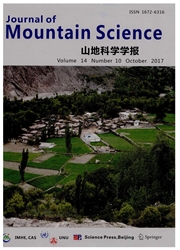

 中文摘要:
中文摘要:
极端天气事件在在高高度区域驾驶生态系统动力学起了一个重要作用,但是内在的机制仍然保持不清楚。理解是否并且一个生态系统的土壤过程怎么反应到极端干旱,我们操作了 once-in-a-century 在西藏的高原上的一块高山的草地的气象学的极端干旱,它也作为全球天气变化的 forerunner 被知道。极限被统计极端天气事件在 19622004 期间从 4 月关于一个历史的引用时期决定到 9 月,在本地历史的降水数据对有 Gumbel 的 100 年的周期性的干旱事件计算、加强的地方我分发。我们测量了的指示物包括了玷污微生物引起的生物资源 C/N/P 并且玷污磷酸酶(AP ) 的酶的活动 disbounding 器官的磷酸盐, cellobiohydrolase (CBH ) , -glucocidase (BG ) ,释放 N 酶 N-acetylglucosaminidase (唠叨) 象土壤呼吸一样,在期间并且在处理以后。操作事件在微生物引起的生物资源和活动导致了快速的移动,这被发现,显示地下的过程的一个更低的电阻。然而,微生物引起、生物化学的参数在事件以后看见了快速的恢复,它意味着土壤过程享受了高跳回。土壤指示物的高应答和落后时间效果显示了新地平线让我们评估在极端和生态系统稳定性之间的相互作用。我们的学习显示 once-in-a-century 极端干旱在土壤导致了很短的学期反应关於生命的过程,和土壤过程在观察时期下面对如此的事件工作了到缓冲区。
 英文摘要:
英文摘要:
Extreme weather events have played an important role in driving the ecosystem dynamics in high altitude areas, but the underlying mechanism remains unclear. To understand if and how the soil processes of an ecosystem react to extreme drought, we manipulated a once-in-a-century meteorological extreme drought in an alpine meadow on the Tibetan Plateau, which is also known as the "forerunner of global weather changes". The extremity was determined by statistical extreme weather events with respect to a historical reference period from April to September during 1962 - 2004, where the local historical precipitation data was calculated and intensified to loo-year recurrent drought event with Gumbel I distribution. The indicators we measured included soil microbial biomass C/N/P and soil enzymatic activities of phosphatase (AP) disbounding organic phosphate, cellobiohydrolase (CBH), β- glucocidase (BG), N-releasing enzyme N-acetyl- glucosaminidase (NAG) as well as soil respirations, during and after the treatments. It was found that the manipulated event induced a rapid shift in microbial biomass and activities, indicating a lower resistance of the underground process. However, the microbial and biochemical parameters saw rapid recovery after the event, which meant the soil processes enjoyed high resilience. The high responsiveness and lag-time effects of the soil indicators rendered new horizons for us to evaluate the interaction between the extremes and the ecosystem stability. Our study indicated that the once-in-a-century extreme drought induced very short term response in the soil biotic process, and the soil processes worked to buffer against such events under the observation period.
 同期刊论文项目
同期刊论文项目
 同项目期刊论文
同项目期刊论文
 Research on soil-dynamics: A simulated case study on a once-in-a-century drought in an alpine meadow
Research on soil-dynamics: A simulated case study on a once-in-a-century drought in an alpine meadow Runoff and soil loss in a typical subtropical evergreen forest stricken by Wenchuan Earthquake: thei
Runoff and soil loss in a typical subtropical evergreen forest stricken by Wenchuan Earthquake: thei 期刊信息
期刊信息
